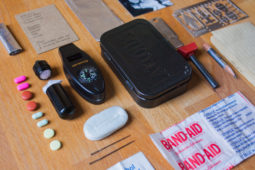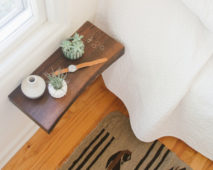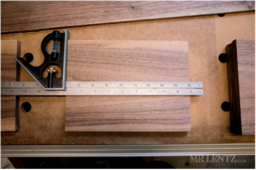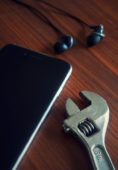ManMade Essential Toolbox: Why Every Workshop Needs a Really, Really Good Jig Saw (and Which One to Buy)
Each week in 2015, ManMade is sharing our picks for the essential tools we think every creative guy and DIYer needs. We've selected useful, long-lasting tools to help you accomplish a variety of projects, solve problems, and live a hands-on lifestyle that allows you to interact with and make the things you use every day.

Woodworking and DIY tasks are often about keep things straight. That is: flat, square, true, non-bowed, non-cupped, planed, and jointed. There's a half a dozen tools in the shop dedicated to doing one or a few of those things, with complex fences and tables to ensure everything stays square.
And my favorite power tool laughs in the face of all those things. It not only is intended to cut curves and complex shapes, but can do so not just in solid wood, but in metal, plastic, laminate, ceramic, and plywood. We're talking about the jig saw, which is, by far, the most fun tool in the shop, and surprisingly versatile.
Of course, no tool is more frustrating when it doesn't work. I went through three (3!) jig saws before I found one that wouldn't vibrate the material to death, had quality blade tracking, and produced great cuts. So, unfortunately, this isn't a $50 tool. But, get the right one, and you'll save on materials and headaches, cause a good jig saw does just what it's asked.

What Makes for a Good Jig Saw?
In short – control. The design of a jig saw (also called a sabre saw or handheld scroll saw by some) means it's necessarily more difficult to get clean cuts. The blades are small, thin, and relatively weak (you can bend them with one finger), and they're completely unsupported at the bottom. Using the tool requires it to cut at a variety of speeds both with and across the grain of the wood (and every degree in between).
The best tools have three key features: quality blade rollers that keep the blade in place just above the sole, a powerful and smooth motor, and a heavy cast aluminum or steel sole that helps dampen vibrations. Also look for easy adjustment of the bevel, which allows you to make complex angled and curved cuts. The best saws have stout blade releases made of high quality parts that will last for many blade changes to come, and include blowers to keep saw dust away from the cut line, so you can see where you're going.
You'll also want a variety of speeds for working in different material, but that's standard on most saws these days. Worry more about a big, smooth motor and precision rather than the bells and whistles.

How to Get Smooth Cuts with a Jig Saw
A bit of prep work will guarantee a great cut.
1) Always draw a line, and never cut on it. Rather, stay to the outside of your line. This guarantees you wont remove too much material, and the angle of the blade won't force you off your mark. Once you shape is roughed out, you can sand to the line.
2) Support your cut on both sides. Because of the design of the tool and the nature of the cuts made, you need to cover a lot of ground over your material. So, you can't just hang it off a bench and have at it. You'll get too much vibration, ruining your cut. Always support both sides of the material, and rest your body against the wood, etc, to dampen the impact. Sawhorses are great here, as are those little flip up work benches. I often use the expandable wing of my table saw, which allows me to support the work with either side of the extension, with a nice empty space in-between.
3) Clamps! Use them. Many of them. Enough said.
4) Make sure the saw is running fully before it touches wood. This is important for all power tools, but especially necessary with the up and down cutting action of a jig saw. Never let the teeth grab the wood and take the material with the blade (kickback? kickup?); when the saw is at full speed, it will cut what's in its path. If you need to stop and start the blade in the middle of the cut, create some extra space in the waste where you can insert the blade and start the motor before moving the saw.
5) You can always approach the line from another angle. If you have an especially tight or complex curve to cut, start at one side, then come in from another side to maintain control. These are called 'relief cuts' and will allow the waste to fall out of the way, so you can concentrate on keep things smooth.
What's the Best Jig Saw?
You can see from the photos that I'm a big fan of the Bosch tool. If this one every dies, I'd replace it in a heartbeat with its equivalent. And if the quality changes, I'd buy a used one. There are a couple other great affordable options out there (expect to spend $90 – $250), but you'll never go wrong with a Bosch model. They may be pricier, but they're worth it, and last for many, many cuts to come.
ManMade Recommended:
- Bosch JS470E 120-Volt 7.0-Amp Top-Handle Jigsaw – $157.50
- Bosch JS572EL 120-Volt Top-Handle Jig Saw With L-BOXX 2 – $259.00 (No, this isn't too much to spend on a jig saw. Read the reviews, and you'll see why)
- DEWALT DW317 Variable-Speed Orbital Jigsaw – $114.50
- Milwaukee 6268-21 6.5 Amp Top Handle Jig Saw – $193.36
Also, you'll want these, too:
- Portamate PM-3300T Sawhorses
- Bosch 101AO 3-Inch 20-Tooth Jig Saw Blades, 5-Pack (if you'll ever get excited about a saw blade, this is it)











